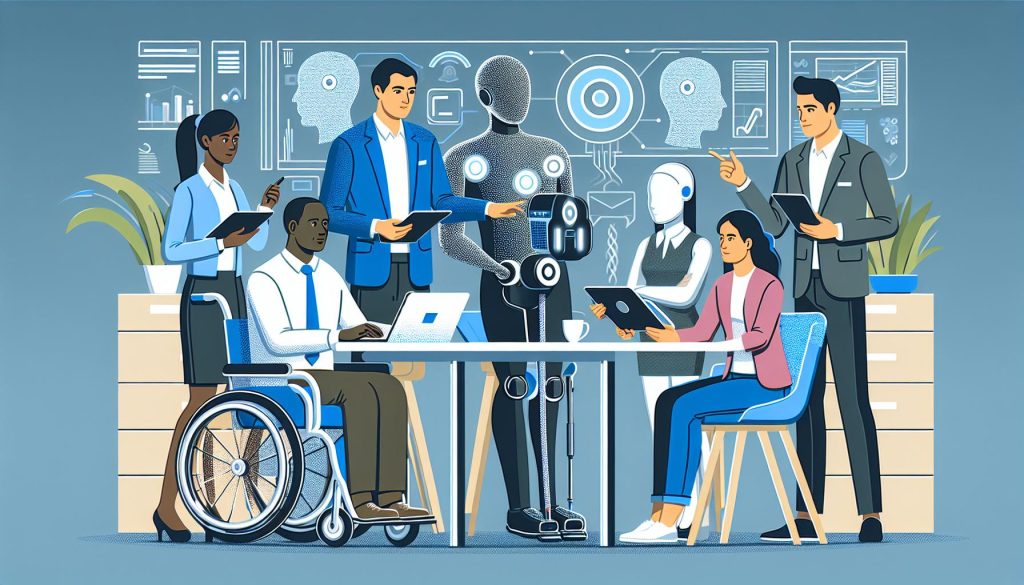In the intricate dance of law and technology, a new performer has stepped onto the stage: prompt engineering. This emerging field offers a fascinating blend of efficiency and accuracy, promising to revolutionize the way legal professionals approach their work. As they navigate the complex web of statutes, case law, and legal precedents, lawyers and paralegals are finding an unexpected ally in the algorithms and data models that power prompt engineering. It’s a partnership that not only accelerates the pace of legal research and documentation but also enhances the precision of legal outcomes.
The promise of prompt engineering in the legal arena is not just about doing things faster; it’s about doing them better. By harnessing the capabilities of advanced technology, legal practitioners are able to sift through mountains of data with unprecedented speed and accuracy. This synergy between human expertise and machine intelligence opens up new avenues for tackling the ever-evolving challenges of the legal field. As we delve deeper into the applications of prompt engineering in law, it becomes clear that this is not merely a tool for efficiency—it’s a catalyst for innovation, driving the legal profession towards a future where justice is served with both swiftness and precision.
Understanding Prompt Engineering in Legal Contexts
Prompt engineering emerges as a pivotal methodology in transforming legal operations by structuring prompts to effectively communicate with algorithms. This approach enhances legal research, analysis, and documentation, allowing legal professionals to navigate vast data sets with precision and speed. In legal contexts, prompt engineering optimizes the interaction between human expertise and artificial intelligence (AI), improving the delivery of legal services.
Legal professionals leverage prompt engineering to refine the search and retrieval of case laws, statutes, and legal precedents. By crafting specific and targeted prompts, lawyers and paralegals can access the most relevant information from legal databases, reducing research time. This precision in information retrieval contributes to the preparation of more accurate legal documents and advice.
Moreover, prompt engineering in legal applications supports compliance monitoring and risk assessment. Lawyers design prompts that help AI tools identify potential compliance issues within large volumes of documents. This proactive identification aids firms in mitigating legal risks before they escalate, ensuring adherence to regulatory requirements.
The implementation of prompt engineering also extends to contract analysis and management. Legal teams develop prompts that assist AI in extracting key clauses and terms from contracts, facilitating quicker review processes. This not only accelerates negotiations but also enhances the accuracy of contract risk evaluations.
In the litigation domain, prompt engineering enables the synthesis of legal arguments and the prediction of case outcomes by analyzing historical data. Legal practitioners design prompts that guide AI in sifting through past rulings and decisions, offering insights that inform strategy development.
As the application of prompt engineering grows within the legal field, it presents an evolving landscape for legal professionals. While the focus remains on enhancing efficiency and accuracy, prompt engineering also opens avenues for job creation. Roles centered around designing and refining legal prompts are becoming integral, marking the intersection of legal expertise and technological proficiency in creating a modern legal workforce.
The Efficiency of Prompt Engineering in Legal Research

Prompt engineering significantly enhances efficiency in legal research by designing intricately structured questions that bolster the interaction between AI tools and legal professionals. This advancement permits the rapid retrieval of case law, statutes, and other legal documents, thereby reducing the hours traditionally required for legal research.
Leveraging machine learning algorithms, prompt engineering tailors search queries that align closely with specific legal queries. These structured prompts ensure that the AI focuses on the most relevant statutes, case laws, and legal principles, leading to more precise and useful results. Instead of sifting through irrelevant information, legal researchers receive targeted responses, which saves considerable time and effort.
Furthermore, prompt engineering aids in the continuous update and tracking of legal changes, facilitating compliance and reducing the risk of overlooking critical regulatory updates. It seamlessly integrates into legal databases, enabling real-time updates and notifications on relevant legal developments. This capacity ensures legal practitioners remain informed about the latest laws and regulations without conducting manual searches.
In the domain of contract analysis and review, prompt engineering simplifies complex legal language, making it easier to identify key clauses and potential issues. By inputting specific prompts, legal professionals can quickly extract and analyze contractual obligations, rights, and liabilities, enhancing their efficiency in drafting, reviewing, and negotiating contracts.
Beyond mere research, the role of prompt engineering extends to predictive analysis, where it assists in forecasting case outcomes based on historical data and current legal standards. Such forecasts support legal strategy formulation, allowing attorneys to advise their clients more accurately.
As prompt engineering in the legal field matures, it not only boosts research efficiency and accuracy but also paves the way for new career opportunities at the nexus of law and technology. Roles that combine legal acumen with technical skills in AI and machine learning are becoming increasingly essential, reflecting a growing demand for prompt engineering jobs in the legal sector.
Enhancing Accuracy with Prompt Engineering in Legal Analysis

Prompt engineering significantly elevates the accuracy of legal analysis by leveraging structured interactions between legal professionals and artificial intelligence (AI). This innovative technique employs meticulously crafted prompts that enhance AI’s understanding of complex legal queries, facilitating precise and relevant legal interpretations. Legal analysts deploy prompt engineering to dissect intricate legal documents, interpret legislation, and analyze case law with higher accuracy rates, which is critical in delivering sound legal advice and making informed decisions.
In contract analysis, for instance, prompt engineering allows for the extraction of specific clauses and obligations with remarkable precision, reducing the risk of overlooking critical details. This precise extraction ensures that legal professionals can assess compliance, obligations, and potential liabilities more efficiently and accurately. Similarly, in litigation support, crafted prompts guide AI in sifting through vast amounts of case law and legal precedents, identifying relevant cases and legal principles that align closely with the matter at hand. This targeted retrieval not only saves time but also significantly improves the relevance and applicability of the information obtained.
Furthermore, prompt engineering plays a crucial role in regulatory compliance monitoring. By tailoring prompts to monitor changes in legislation and regulations, legal professionals can stay abreast of current legal standards, ensuring that advice and compliance strategies are up-to-date and accurate. This proactive approach minimizes the risk of non-compliance and helps in maintaining the legal integrity of organizations.
The application of prompt engineering in legal analysis also has implications for the job market, creating new opportunities at the intersection of law and technology. As demand for this specialized skill grows, careers in prompt engineering within the legal sector are burgeoning. Legal professionals with proficiency in prompt engineering are becoming invaluable for their ability to enhance the precision and efficiency of legal services, indicating a promising area for professional growth in the intersection of legal expertise and technological adeptness.
Ethical Considerations and Challenges
The integration of prompt engineering in the legal field, while enhancing efficiency and accuracy, raises significant ethical considerations and challenges. A core concern is the potential for bias in AI-generated legal analysis. Prompt engineering relies on data to train AI models, and if this data contains biases, the AI’s legal interpretations may inadvertently perpetuate these biases, affecting fairness and impartiality in legal decisions.
Protecting client confidentiality represents another ethical challenge. Legal professionals must ensure that the AI systems they use for prompt engineering do not compromise sensitive client information. This involves scrutinizing the security features of these systems and adhering to strict data protection regulations.
There’s also the issue of accountability. In scenarios where AI-driven legal analyses lead to incorrect decisions or advice, determining liability becomes complex. Legal professionals must navigate the delicate balance between leveraging AI’s capabilities and maintaining ultimate responsibility for the advice given to clients.
Furthermore, the adoption of prompt engineering in the legal sector necessitates ongoing training and supervision. Legal professionals need to stay informed about the latest developments in AI and prompt engineering to effectively mitigate risks and uphold ethical standards.
Despite these challenges, the legal sector’s interest in prompt engineering continues to grow. This growth signals a need for clear guidelines and frameworks to address ethical concerns and ensure that the application of AI in law serves to advance justice rather than hinder it. As prompt engineering careers and jobs expand, professionals entering this field must be equipped with not only technical skills but also a deep understanding of the ethical implications of their work.
The Future of Legal Applications of Prompt Engineering
The future of legal applications of prompt engineering lies in its potential to further refine the efficiency and accuracy of legal processes. As the integration of artificial intelligence (AI) with legal expertise continues to evolve, the demand for professionals skilled in prompt engineering in the legal sector is expected to rise significantly. This growth suggests an expanding arena for prompt engineering careers, with specialized roles emerging to design, implement, and refine AI-driven legal tools.
One notable area of future development is the advancement of AI in producing more nuanced legal interpretations and predictions. Prompt engineering techniques will be instrumental in training AI systems to parse through complex legal documents and precedents with a higher degree of precision. This evolution will enable legal professionals to tackle intricate cases more efficiently, with AI providing well-informed suggestions that can guide legal decisions and strategies.
Moreover, as AI becomes more entrenched in legal practices, the role of prompt engineers in ensuring AI’s ethical application will become crucial. They’ll be responsible for creating prompts that help AI navigate the delicate balance of legal ethics, client confidentiality, and the unbiased interpretation of law. This responsibility indicates a shift towards a more interdisciplinary approach in legal professions, where knowledge of law, technology, and ethics converges.
In terms of compliance monitoring, AI enhanced by prompt engineering is poised to offer more dynamic and real-time solutions. These systems can assist firms in staying abreast of regulatory changes and understanding their implications swiftly, thereby minimizing risks of non-compliance. Here, prompts engineered to continuously adapt to evolving legal standards and requirements will be key in maintaining the relevance and effectiveness of compliance tools.
The expansion of prompt engineering applications in law also hints at collaborative job opportunities, where professionals from legal, tech, and ethical backgrounds work together to craft AI-driven solutions. Such collaborations can lead to the development of more robust, fair, and transparent legal AI tools, thereby fostering trust in AI’s role within legal contexts.
Ultimately, the future of legal applications of prompt engineering will be characterized by a blend of technological innovation and ethical stewardship. As the field matures, the emphasis on creating AI that not only understands legal language but also upholds the principles of justice and equity will remain paramount.
Conclusion
The transformative impact of prompt engineering on the legal sector is undeniable. By marrying AI’s computational power with human legal expertise, it’s reshaping how legal professionals approach research, analysis, and compliance. The evolution towards more AI-driven legal tools not only promises to enhance the precision and efficiency of legal processes but also opens the door to innovative job roles within the field. As the technology advances, the ethical and practical implementation of AI in law will become increasingly critical. The collaborative efforts of legal, tech, and ethics professionals will be paramount in ensuring that AI’s integration into legal systems remains just and equitable. With a focus on innovation and adherence to ethical standards, the future of legal prompt engineering is poised to redefine the landscape of legal practice, making it more efficient, accurate, and fair.


